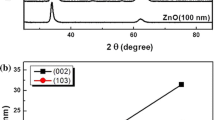Abstract
Oxides and silicates of zirconium and hafnium are actively being considered and tested to replace SiO2 as the gate material. Though these materials have the high-dielectric constant (k ∼ 20–25) needed to provide a larger equivalent oxide thickness, they are very refractory and difficult to etch by wet and dry methods. In this paper, work done on wet etching of ZrO2, HfO2, and HfSixOy in dilute hydrofluoric acid (HF) solutions is presented and discussed. Experiments were done on various high-k films deposited by metalorganic chemical vapor deposition. It was found that the as-deposited high-k films can be dissolved with a good selectivity over SiO2 in dilute HF solutions, but heat-treated high-k films are difficult to etch with good selectivity over SiO2 under the same conditions.
Similar content being viewed by others
References
The International Technology Roadmap for Semiconductors (2001).
R. Degraeve, B. Kaczer, and G. Groeseneken, Reliability: A possible showstopper for oxide thickness scaling? Semicon. Sci. Technol. 15, 436 (2000).
R. Nieh, K. Onishi, R. Choi, E. Dharmarajan, S. Goplan, C.S. Kang, and J.C. Lee, High-K gate dielectrics: HfO2, ZrO2 and their silicates, Proceedings – Electrochemical Society, 2001-9 (Rapid Thermal and Other Short-Time Processing Technologies II), 171 (2001).
G.D. Wilk, R.M. Wallace, and J.M. Anthony, Hafnium and zirconium silicates for advanced gate dielectrics, J. Appl. Phys. 87, 484 (2000).
G.D. Wilk, R.M. Wallace, and J.M. Anthony, High-k gate dielectrics: Current status and materials properties considerations, J. Appl. Phys. 89, 5243 (2001).
G.D. Wilk and R.M. Wallace, Electrical properties of hafnium silicate gate dielectrics deposited directly on silicon, Appl. Phys. Lett. 74, 2854 (1999).
G.D. Wilk and R.M. Wallace, Stable zirconium silicate gate dielectrics deposited directly on silicon, Appl. Phys. Lett. 76, 112 (2000).
W. Vandervorst, B. Brijs, H. Bender, O.T. Conard, J. Petry, O. Richard, S. Van Elshocht, A. Delabie, M. Caymax, and S. De Gendt, Physical characterization of ultrathin high k dielectrics, in Novel Materials and Processes for Advanced CMOS, edited by M.I. Gardner, S. De Gendt, J-P. Maria, and S. Stemmer, (Mater. Res. Soc. Symp. Proc. 745, Warrendale, PA, 2003) p. 230.
D. Watanabe, H. Momota, T. Kezuka, K. Takashi, I. Mitsushi, D. Riley, and J. Barnett, Selective wet etching for high-k material by organic solvent containing hydrofluoric acid, Semiconductor Pure Water and Chemicals Conference Proceedings, 22nd, 117, (2003).
J.J. Guan, G.W. Gale, G. Bersuker, M. Jackson, and H.R. Huff, Chemical processing and material compatibility of high-k dielectric materials for advanced gate stacks, Diffusion and Defect Data-Solid State Data, Pt. B: Solid State Phenomena, 76-77 (Ultra Clean Processing of Silicon Surfaces 2000), 19, (2000).
A. Agarwal, M. Freiler, P. Lysaght, L. Perrymore, R. Bergmann, C. Sparks, B. Bowers, J. Barnett, D. Riley, Y. Kim, B. Nguyen, G. Bersuker, E. Shero, J.E. Lim, S. Lin, J. Chen, R.W. Murto, and H.R. Huff, Challenges in integrating the high-k gate dielectric film to the conventional CMOS process flow, in Gate Stack and Silicide Issues in Silicon Processing II, edited by S.A. Campbell, L.A. Clevenger, P.B. Griffin, and C.C. Hobbs, (Mater. Res. Soc. Symp. Proc., 670, Warrendale, PA, 2002) p. K2.1.1.
K.L. Saenger, H.F. Okorn-Schmidt, and C.P. D’Emic, A selective etching process for chemically inert high-k metal oxides, in Novel Materials and Processes for Advanced CMOS, edited by M.I. Gardner, S. De Gendt, J-P. Maria, and S. Stememr, (Mater. Res. Soc. Symp. Proc. 745, Warrendale, PA, 2003), p. 29.
M.A. Quevedo-Lopez, M. El-Bouanani, R.M. Wallace, and B.E. Gnade, Wet chemical etching studies of Zr and Hf-silicate gate dielectrics, J. Vac. Sci. Technol. A, 20, 1891 (2002).
K. Christenson, B. Schwab, T. Wagener, B. Rosengren, D. Riley, and J. Barnett, Selective wet etching of high-k gate dielectrics, Diffusion and Defect Data—Solid State Data, Pt. B: Solid State Phenomena, 92 (Ultra Clean Processing of Silicon Surfaces V), 129 (2003)
J. Barnett, D. Riley, T.C. Messina, P. Lysaght, and R. Carpio, Wet etch enhancement of HfO2 films by implant processing, Diffusion and Defect Data—Solid State Data, Pt. B: Solid State Phenomena, 92 (Ultra Clean Processing of Silicon Surfaces V), 11 (2003).
Hsin-Hsiung Huang, STABCAL software, Metallurgical Engineering, Montana Tech., Butte, MT 59701, USA.
D.M. Knotter, Etching mechanism of vitreous silicon dioxide in HF-based solutions, J. Am. Chem. Soc. 122, 4345 (2000).
W. Janusz, Surface charge and adsorption of Na+ and Cl− ions at the zirconium dioxide water interface, J. Radioanal. Nucl. Chem. 125, 393 (1988).
Author information
Authors and Affiliations
Rights and permissions
About this article
Cite this article
Lowalekar, V., Raghavan, S. Etching of Zirconium Oxide, Hafnium Oxide, and Hafnium Silicates in Dilute Hydrofluoric Acid Solutions. Journal of Materials Research 19, 1149–1156 (2004). https://doi.org/10.1557/JMR.2004.0149
Received:
Accepted:
Published:
Issue Date:
DOI: https://doi.org/10.1557/JMR.2004.0149



